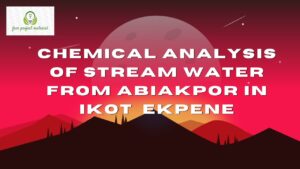This project is about the Assessment of Trace Metals in Borehole Water From Mbiaobong in Ini L.G.A. of Akwa Ibom State, It is suitable for final year research project work for both Polytechnic and University Undergraduate. The project is made up of 5 chapters, well arranged and have been properly vetted by qualified lecturers and presented in accredited recognized tertiary institutions
ABSTRACT
The levels of six trace metals namely iron, lead, copper, zinc and nickel were investigated in drinking water and ground water sources in Mbiaobong village, ini L.G.A, Akwa Ibom State . Detected concentrations of Mn, Cu and Zn were below the world health organization and standard organization of Nigeria maximum permissible units. Fe (92%) and N1 (55%) in some drinking water and groundwater sources were found in concentration that exceeded the maximum permissible limits for these metals. Notably, the levels of Pb were below detection limit in borehole water. Pollution indices indicated significant Pollution of Pb, Fe and Ni. Over all, the mean metal levels in the sampled water sources followed a descending order Fe>Cu> Zn> Ni> Pb.> Mn. Some of considered safe for drinking, but proactive measures should be taken to check the levels of Fe, Pb and Ni on the Borehole.
TABLE OF CONTENTS
Title page- – – – – – – – – – i
Certification – – – – – – – – – ii
Dedication – – – – – – – – – – iii
Acknowledgments- – – – – – – – iv
Abstract – – – – – – – – – – v
CHAPTER ONE
1.0 Introduction – – – – – – – – –
1.1 Aim and Objective of the Study- – – – –
1.2 Scope and Limitation- – – – – – –
1.3 Significance of the study- – – – – –
1.4 Definition of terms- – – – – – –
CHAPTER TWO
2.0 Literature Review- – – – – – –
2.1 Water- – – – – – – – –
2.2 Properties of Water- – – – – – –
2.3 Water Pollution- – – – – – – –
2.4 Human Uses of Water – – – – – – –
2.5 Water Pollution- – – – – – – –
2.6 Water Quality- – – – – – – –
2.7 Trace Metals – – – – – – – –
2.7.1 Lead (Pb)- – – – – – – – –
2.7.2 Chromium (Cr)- – – – – – – –
2.7.3 Cadmium (Cd)- – – – – – – –
2.7.4 Copper (Cu)- – – – – – – –
2.7.5 Iron (fe)- – – – – – – – –
2.7.6 Zinc (Zn)- – – – – – – – –
2.7.7 Mercury (Hg)- – – – – – – –
2.8 Health Effects of Trace Metals- – – – –
2.9 Remediation of Trace Meals – – – – – –
CHAPTER THREE
3.0 Materials and methods- – – – – – –
3.1 Materials- – – – – – – – –
3.2 Source of Sample Collection- – – – – –
3.3 Sample Preparation – – – – – – – –
3.4Trace Metal Analysis- – – – – – – –
CHAPTER FOUR
4.0 Results and Discussion- – – – – – –
4.1 Results – – – – – – – – –
4.2 Discussion- – – – – – – – –
CHAPTER FIVE
5.0 Conclusion and Recommendations- – – – –
5.1Conclusion – – – – – – – – –
5.2 Recommendations- – – – – – – –
References
CHAPTER ONE
1.0 INTRODUCTION
Water is an essential resource for living systems, industrial processes, agricultural production and domestic use. Ninety seven percent of the worl’s water is found in Oceans. Only 2.5% of the world’s water is non-saline fresh water (Itodo A. U et al., 2010). In recent times there has been as increasing health related concern associated with the quality of drinking water in developing countries. According to a recent report by WHO/UNICEE, about 780 million people in the development world lack access to potable water due largely to microbiological and chemical contaminations. Drinking water sources in these so-called developing countries are under increasing threat from contaminations by chemical physical and microbial pollutant known sources (both naturally occurring and anthropogenic) of chemical contamination of water suppliers include organic and inorganic sustances from industrial effluents, detergents, mining and fertilizers (Ergul et al., 2013) (Ndamitso et al., 2013). Limnic and lacustrine aquatic ecosystem (fresh water lakes, rivers, streams, etc) and ground water (well, borehole, or spring water) are increasing used for refreshment, domestic, industrial and recreation purposes. Surface water systems are particulary vulnerable to pollution that groundwater. However, it has been reported that groundwater contains enhanced concentrations of arsenic, Iron, radioactive element and nitrates attributed to natural process as well as human-mediated activities such as seepages from underground starage facilities and faulty septic systems. Trace metals, among a wide range of contaminates, are consistenly of health, concern due to their toxicity potentials at very low concentrations, and tendency to bioaccumlate in tissues of living organisms over time (Ikejimbe et al., 2014).
1.1 Aim
The aim of this research is to know the Assessment of trace metals in Borehole water.
1.2 Scope and Limitation
The design of this research project is to investigate the assessment of trace metals in drinking water and ground water source.
1.3 Significant of the Study
It is to evaluate the pollution, identify the source of trace metals, assess the potential risk posed by trace metals in the surface water.
1.4 Definition of Terms
Water quality: This refers to the chemical, physical, biological, and radiological characteristic tics of water.
Trace Metals : This are the metals subset of trace element that is, metals normally present in small but measurable amounts in animal and plant cells and tissues and that are a necessary part of nutrition and physiology.
Water pollution : This occurs when harmful substances often chemicals or microorganisms contaminate a stream, river lake or other body of water, degrading water quality and rendering it toxic to humans or the environment.
Groundwater: This is the water found underground in the cracks and spaces in soil. Sand and rock. It is stored in and moves slowly through geologic form actions of soil, sand and rocks caved aquifers.


